
An increasing number of enterprises are actively exploring full-stack alternatives to VMware. Among these, virtualization — being a core component — has become a focal point for evaluation. As a key module of the Arcfra Enterprise Cloud Platform (AECP), the Arcfra Virtualization Engine (AVE) delivers a comprehensive set of virtualization capabilities with higher availability and performance, and enables enterprise users to manage and operate virtual machines (VMs) more efficiently.
What key capabilities does AVE offer? How well does AVE perform compared with VMware vSphere? Are there any real-world cases of replacing vSphere with AVE? In the following sections, we will provide a detailed comparison between AVE and vSphere in terms of core functionalities and share customer stories in vSphere replacement.
AVE vs. vSphere: Key Feature Comparisons
As AECP’s virtualization platform, AVE is developed based on KVM and equipped with complete compute virtualization and VM life cycle management functionalities. It delivers enhanced VM performance and stability through a wide range of optimized features such as dynamic resource scheduling (DRS), VM high availability (HA), GPU passthrough and vGPU support, and network I/O virtualization — making it well-suited for high-performance computing scenarios like AI workloads.
In addition, when used together with the Arcfra Operation Center (AOC), users can take advantage of advanced features such as VM templates, content library, and network traffic visualization to further improve VM management and operational efficiency.
A detailed comparison between AVE and VMware vSphere in terms of virtualization functionality is provided below:
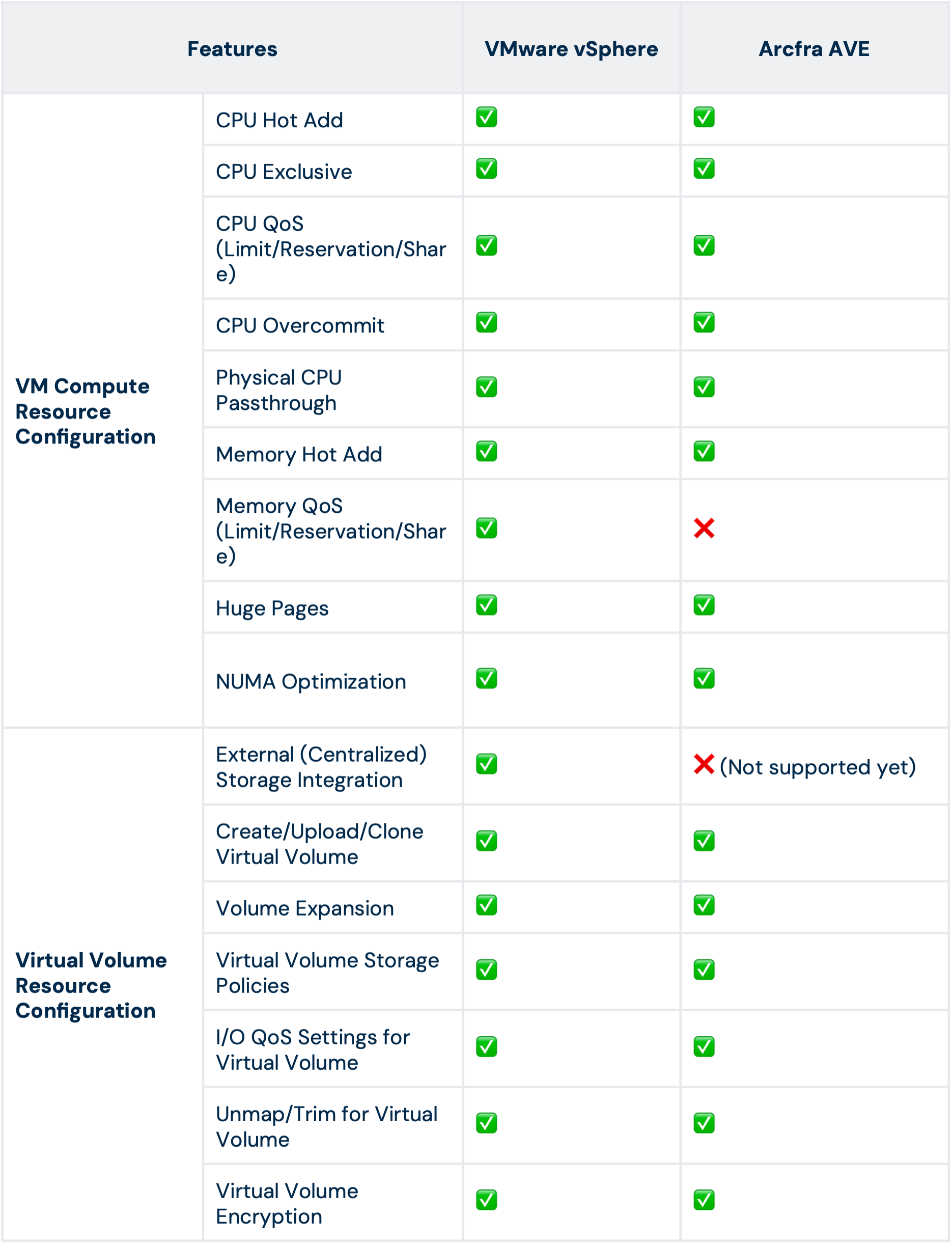
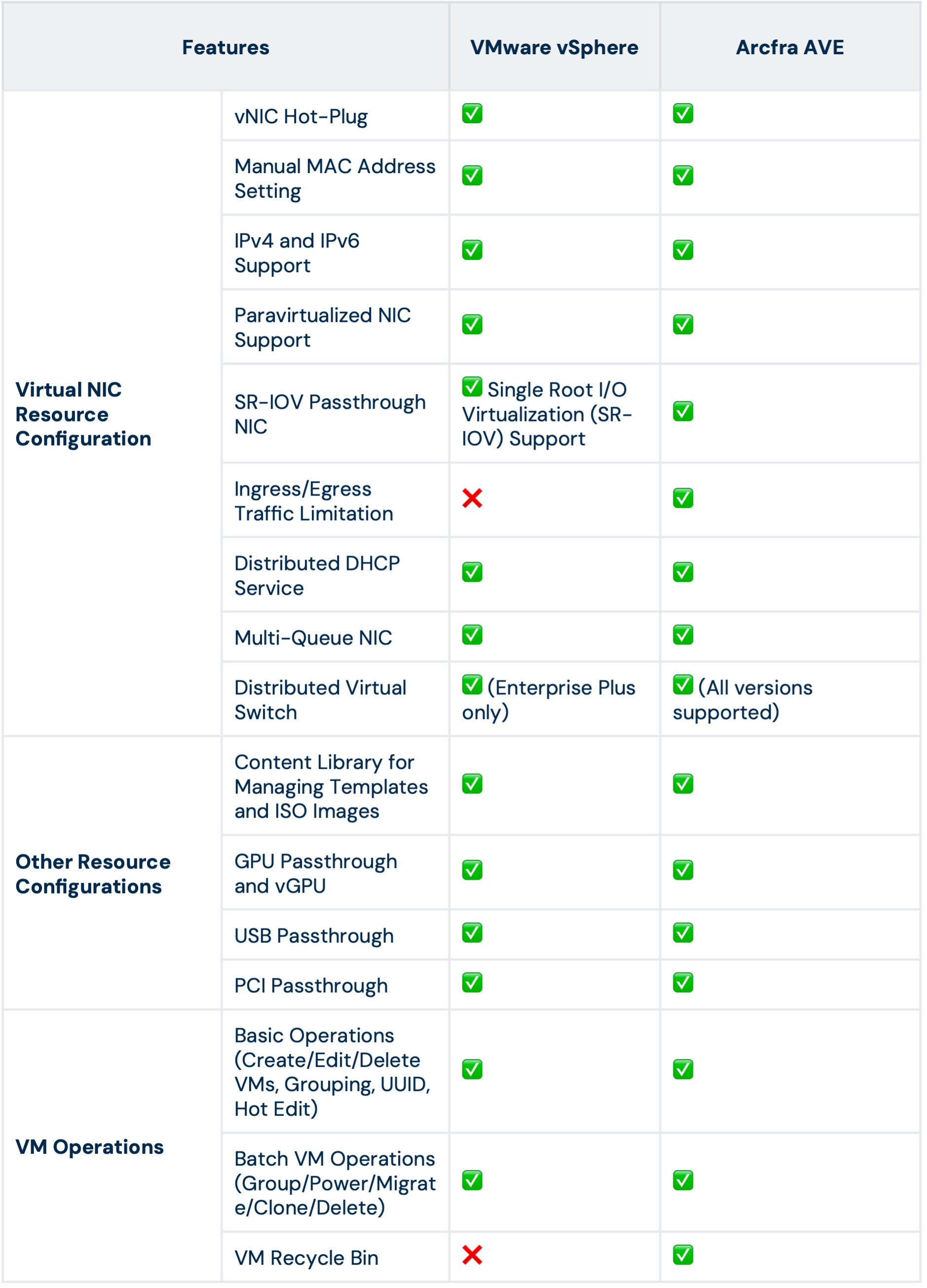
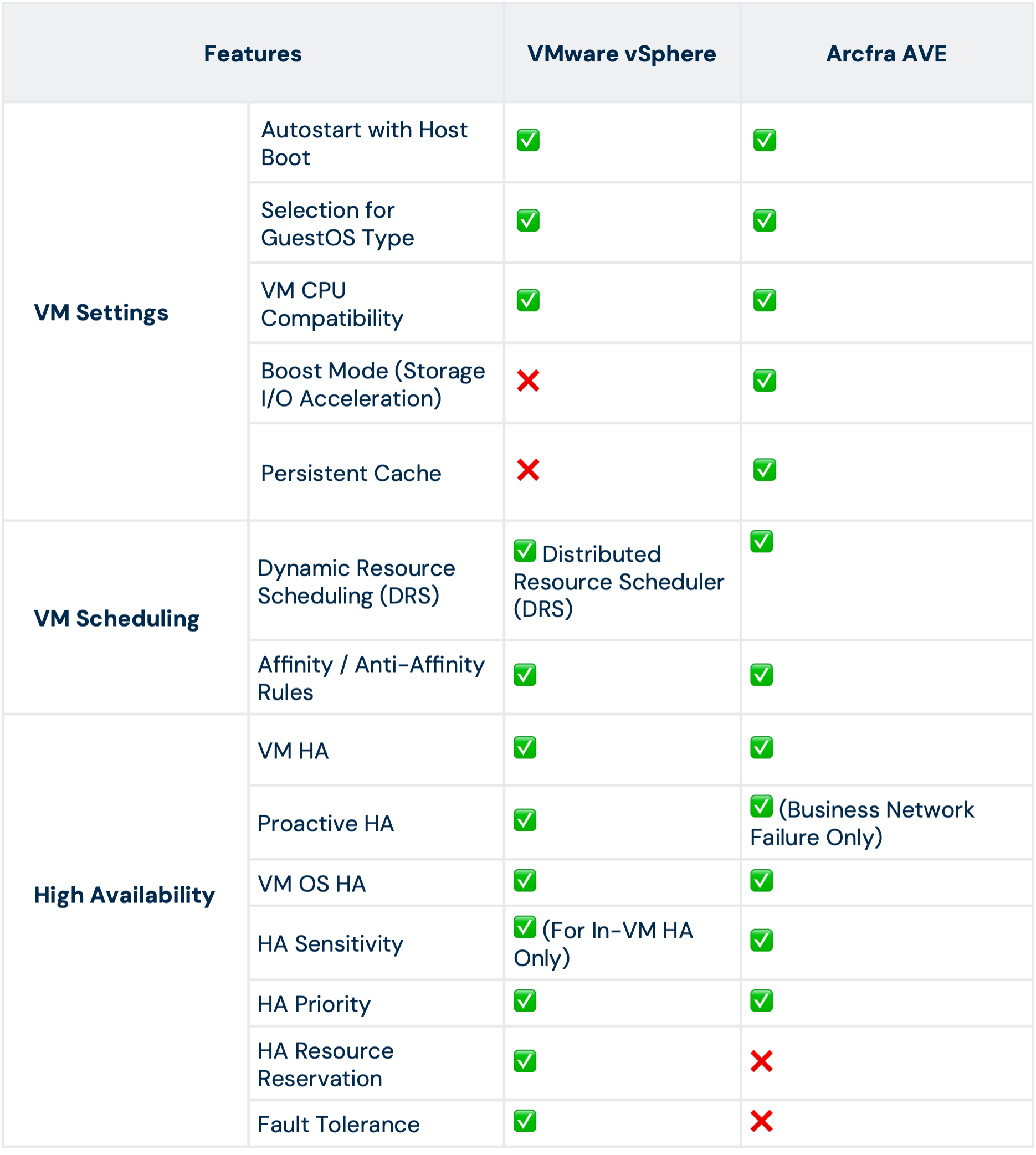
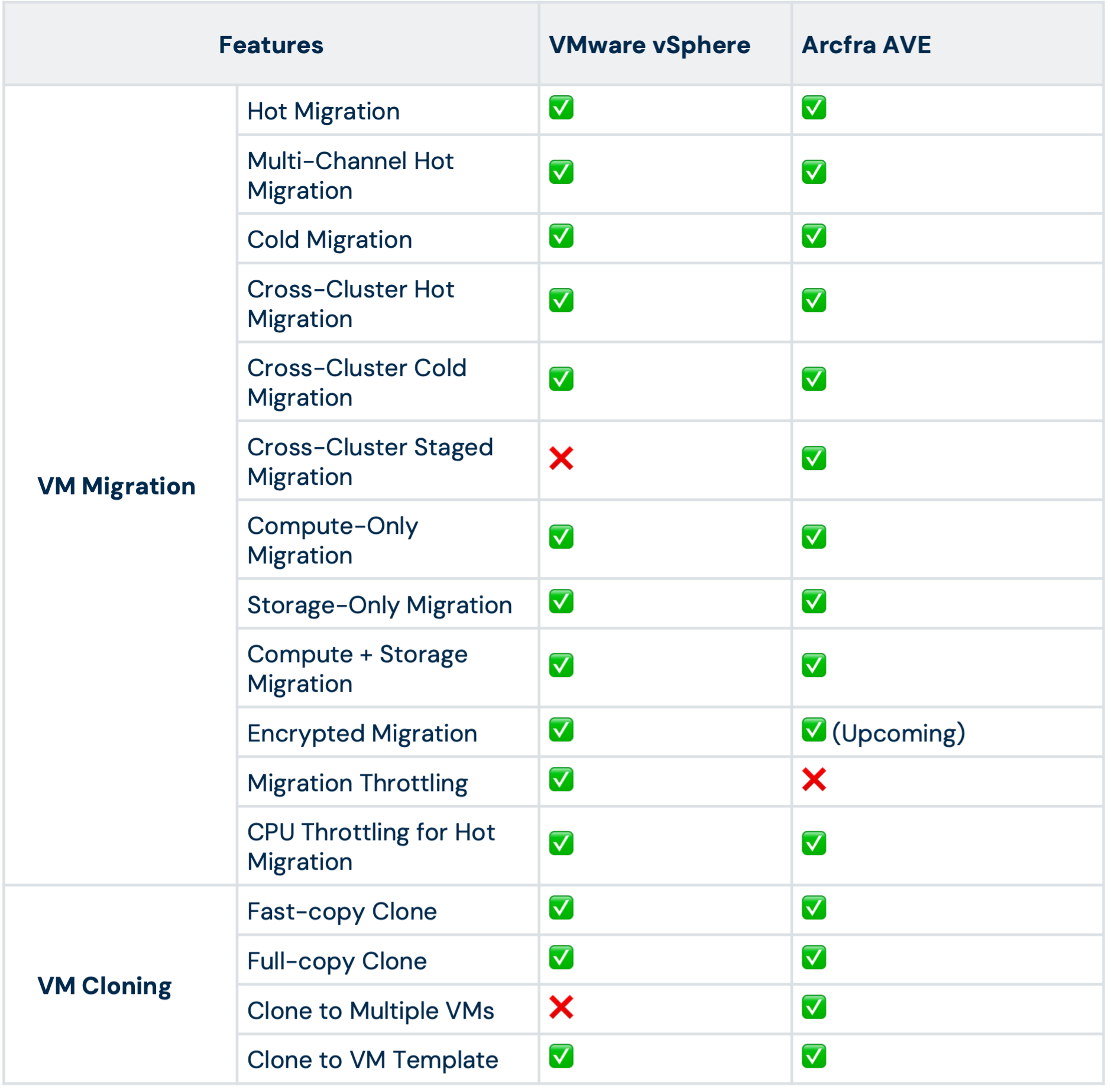
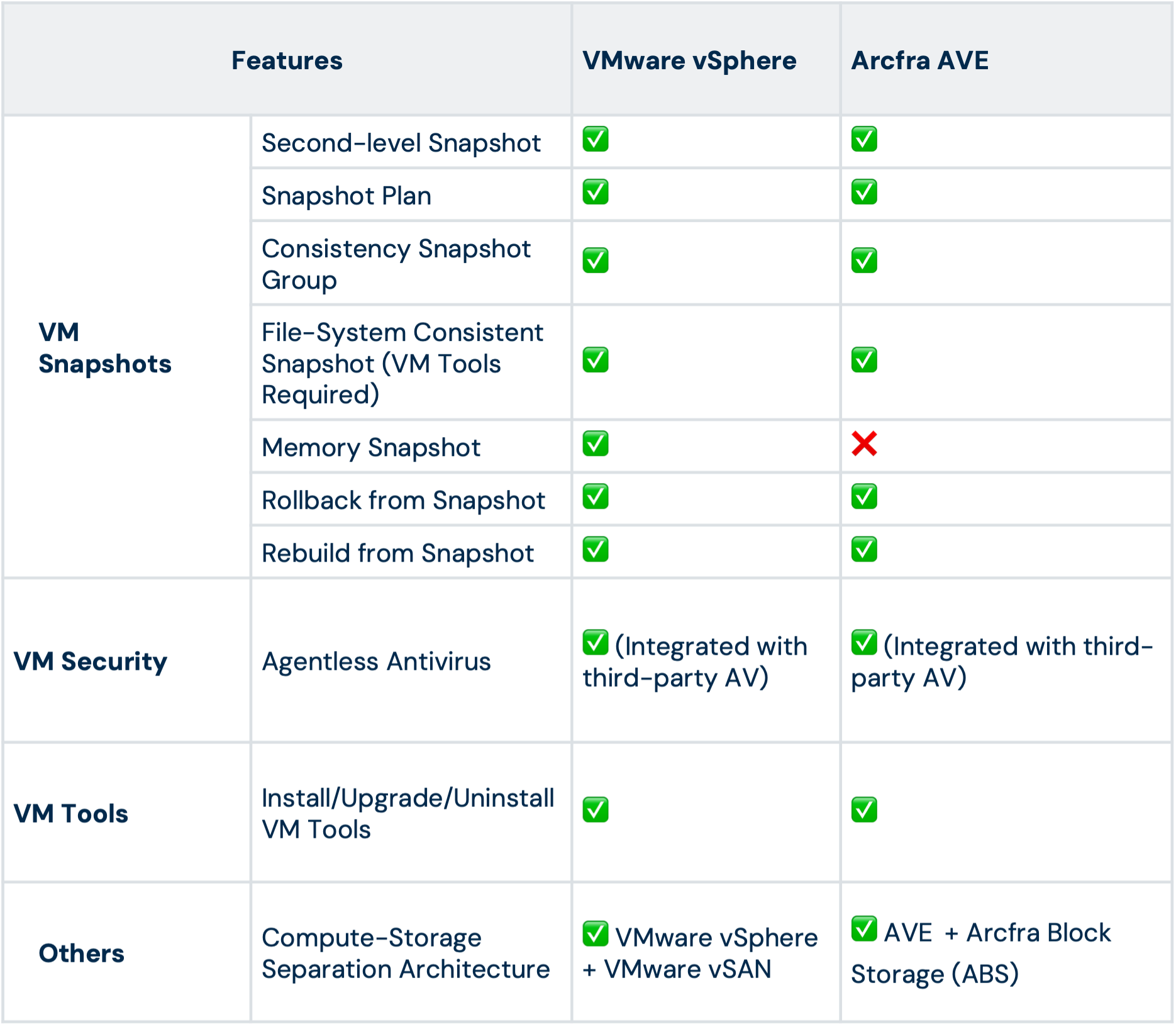
AVE delivers nearly all the enterprise-grade virtualization features provided in VMware vSphere, including VM resource configuration, lifecycle management, VM HA, DRS, as well as VM snapshots and cloning. In addition, AVE offers advanced virtualization capabilities available in vSphere Enterprise Plus, such as SR-IOV passthrough, distributed switches, GPU passthrough, and vGPU, allowing customers to benefit from cutting-edge features with lower licensing costs.
Advantages of AVE as a vSphere Alternative
Production-Grade HA Features
AVE offers multiple features to ensure continuous and stable business operations:
- VM HA: AVE delivers comprehensive fault detection and flexible recovery actions for common failure scenarios to maintain high availability (see table below). Users can also configure VM HA priorities for more granular control.
- Hot Migration: Supports migrating running VMs, enabling seamless hardware maintenance, load balancing, and recovery from VM network failures.
- VM Snapshot: Provides fast VM snapshots, rollback and restore capabilities, including second-level snapshots, file-system consistent snapshots, local snapshot plan, and snapshot list management. >>Learn more
- VM Cloning: Enables creating complete VM replicas, including OS, application data, and configuration, supporting both fast-copy clones (second-level) and full-copy clones (with exclusive storage and superior performance).
- Native Backup & Disaster Recovery: Provides integrated backup and replication services, enabling VM backups, replication, and recovery to ensure resilience.
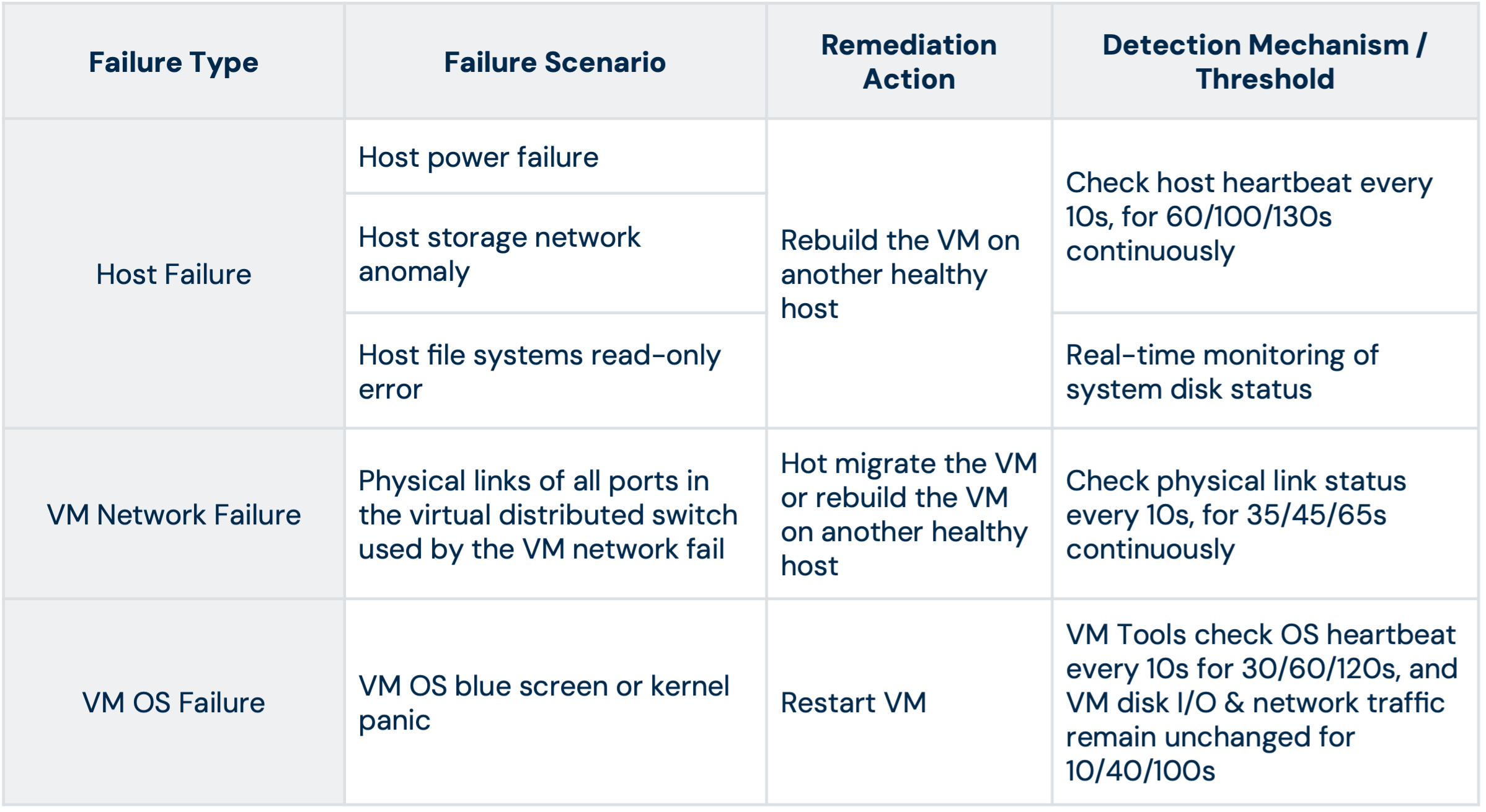
Simple and Intuitive Management
DRS — Broader Scenarios, Easier Operations
AVE establishes an evaluation framework centered on VM responsiveness, extending the applicability of DRS to more diverse application scenarios. The evaluation incorporates storage performance and benefit analysis to reduce unnecessary migrations, optimize decisions, and lower overhead. Sensitivity and automation settings further simplify operations, making it easier for administrators to fine-tune and manage resources efficiently.
Learn More: Arcfra Dynamic Resource Scheduler Explained: Innovating DRS Scoring System for Modernized Applications
USB Passthrough Across Hosts — Shared and Flexible Device Resources
AVE provides a unified USB device list for centralized management of device information. A single USB device can be mounted to multiple VMs, but only one VM can actively use it at a time. Even if the VM is migrated within the cluster, the USB connection remains intact.
Content Library & Cross-Cluster Hot Migration — Simplified Multi-Cluster Resource Management
The content library enables unified management and easy distribution of resources, supporting the unified management of VM templates and ISO images. It allows one-click distribution of bulk VMs across clusters and real-time selection of ISOs or templates from the library when creating VMs.
Besides, in AVE, VMs can migrate across clusters without service interruption, enabling seamless workload scheduling for scenarios such as load balancing, planned maintenance, failover and disaster recovery, and multi-region business expansion.
Performance Optimization
Despite being a KVM-based virtualization platform, AVE has been continuously optimizing its capabilities, especially in performance upgrades, including VM storage acceleration (Boost mode), CPU exclusive, resource reservation and NUMA optimization, high-performance networking via SR-IOV, and DRS.
- Boost Mode: Enables zero-copy I/O between the Guest OS, QEMU, and ZBS via vhost-shared memory, bypassing performance bottlenecks caused by QEMU handling I/O requests. In testing, 4K random read/write IOPS improved by 3–4 times with Boost Mode enabled.
- NUMA-Aware Scheduling: For VMs configured with exclusive CPUs, AVE intelligently allocates resources with the following priorities: same NUMA node > same socket > evenly distributed across fewer sockets. At VM startup, memory is preferentially allocated on the same NUMA node as the assigned CPUs, minimizing latency from cross-NUMA memory access. Real-world tests with a 32 vCPU VM show that enabling NUMA-aware scheduling delivers significant performance gains:
- Sysbench memory test: 5%–114% improvement in multithreaded scenarios, with 12% gain at 32 threads.
- DM database deployment: ~11% performance improvement.
Customers Who Migrated from vSphere to AVE
Today, leading enterprises in financial services, manufacturing, e-commerce, etc., have adopted AECP (AVE) to replace VMware vSphere, supporting their core production workloads, databases, and even AI workloads.
- A large national bank: Deploying over 1,500 AECP (AVE) nodes across HQ and branches data centers to support 10,000+ VMs.
- A top insurance company: Migrating VMware VMs hosting core business services and corresponding MySQL databases to AECP (AVE) clusters.
- Foxconn: Leveraging AECP to replace VMware and integrate production lines in global edge factories. Utilizing ANS to protect east-west traffic security and AKE to support GPU-based workloads.
- ConnectWave: Replacing VMware and physical servers with AECP to modernize E-commerce infrastructure and support AI model training and deployment.
- A century-old Korean hotel: Replacing legacy VMware environment with AECP for higher performance, simplicity, and scalability.
- A leading consumer goods manufacturer in Korea: AECP delivering significant savings on virtualization licensing and maintenance costs.
Read the full customer stories: "Goodbye VMware": 7 Real-World Transformations with Arcfra AECP
Learn more about the features and benefits of AECP as a VMware alternative from our website and previous blogs:
Arcfra Kubernetes Engine vs. vSphere with Tanzu: A Feature-by-Feature Comparison
Arcfra Network Service vs. VMware NSX: Comparable Capabilities, Streamlined Management
Arcfra vs. VMware: VM Snapshot and I/O Performance Comparison
Arcfra vs. VMware: I/O Path Comparison and Performance Impact
Arcfra vs. Nutanix: Key Capabilities and Performance Comparison
Arcfra AECP vs Oracle VirtualBox: VMware Alternatives Compared
Arcfra AECP vs Proxmox VE: VMware Alternatives Compared
Arcfra AECP vs Red Hat OpenShift: VMware Alternatives Compared
Arcfra AECP vs Microsoft Hyper-V: VMware Alternatives Compared
Download your go-to guide for navigating the post-VMware era for free: https://www.arcfra.com/resources/document/vmware-alternatives-ebook/
Arcfra simplifies enterprise cloud infrastructure with a full-stack, software-defined platform built for the AI era. We deliver computing, storage, networking, security, Kubernetes, and more — all in one streamlined solution. Supporting VMs, containers, and AI workloads, Arcfra offers future-proof infrastructure trusted by enterprises across e-commerce, finance, and manufacturing. Arcfra is recognized by Gartner as a Representative Vendor in full-stack hyperconverged infrastructure. Learn more at www.arcfra.com.